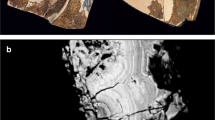Abstract
IN 1957, during a detailed examination of the bauxite deposits in Jamaica, suggested by Dr. D. A. Bryn Davies, managing director of Alumina Jamaica, Ltd., and sponsored by that Company, I noticed the occurrence of a hitherto unrecorded sedimentary band separating red bauxite from underlying white Tertiary limestones. The band is extremely local in occurrence. So far as at present known, it is only typically developed within a limited area around the Kirkvine Works of Alumina Jamaica, near Mandeville, and at Grove Place, about 4 miles to the north-west. It is known to be absent in many other areas. It has, however, certain interesting characteristics which may have some bearing on the history and age of the bauxite deposits. For this reason, and because it may lead to the recording of other occurrences in Jamaica, or even in association with the similar bauxite deposits in Haiti and the Dominican Republic, it seems worth placing on record the following summary account. It is intended to include a more detailed description in a later general account of the bauxite deposits.
Similar content being viewed by others
References
Butterlin, J., “La Constitution géologique et la Structure des Antilles”, 327 (Paris, 1956).
Author information
Authors and Affiliations
Rights and permissions
About this article
Cite this article
EYLES, V. A Phosphatic Band underlying Bauxite Deposits in Jamaica. Nature 182, 1367–1368 (1958). https://doi.org/10.1038/1821367a0
Issue Date:
DOI: https://doi.org/10.1038/1821367a0
- Springer Nature Limited
This article is cited by
-
Minimal health impact from exposure to diet-sourced cadmium on a population in central Jamaica
Environmental Geochemistry and Health (2010)
-
Petrographie und Genese von Bauxitlagerstätten
Geologische Rundschau (1962)





